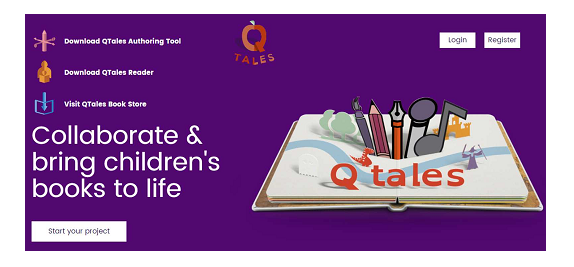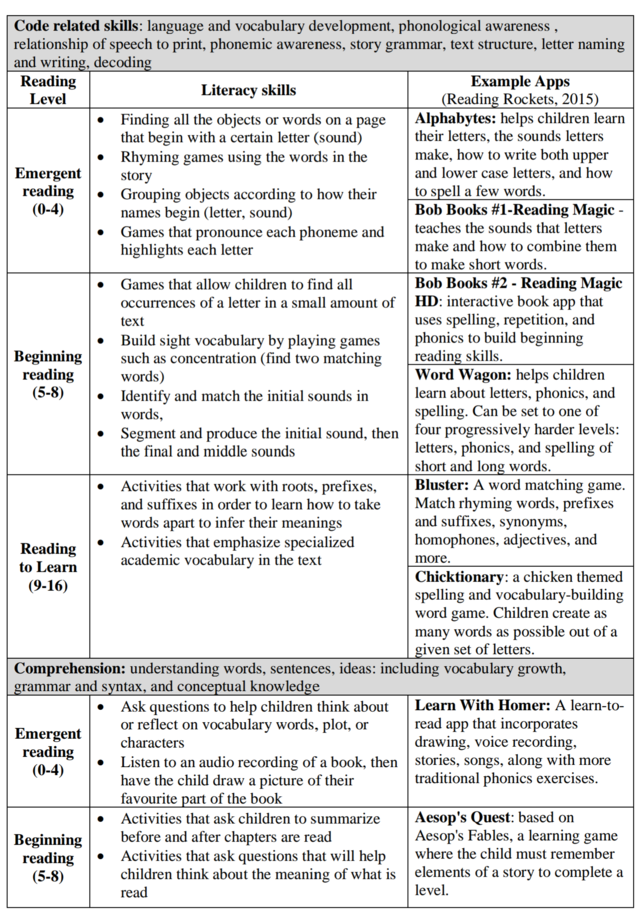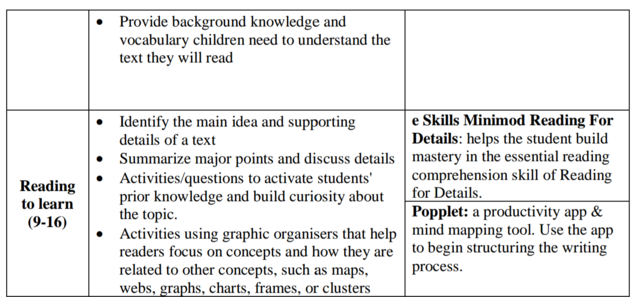Education
A Quantum Leap for Literacy?
Creating the Q-Tales ecosystem for children’s e-book design
Posted May 27, 2017
In the last twenty years, technology has emerged that creates new possibilities for storytelling, creativity and creative education. Innovative and pervasive technologies have been developed, mobilising and ubiquitising computing and digital media. Plowman and Stephen (2003) point to the educational potential of this novel information and communications technology (ICT):
"New technologies may lead to new concepts of play and learning/These shifts in thinking may lead to technologies that can encompass participation by practitioners, parents and children in different learning spaces and promote discovery, delight, curiosity, creativity, self-expression and pleasure in learning." (Plowman & Stephen, 2003, p. 160).
Digital media, interactive storytelling and e-books are ever-present in contemporary education, and consequently play an increasingly important role in the development of children’s nascent and emergent literacy. Liebeskind (2015a) notes that children have been using electronic books (e-books) since the early 1990s, with the introduction of the Living Books CD-ROM books.
The introduction of new technologies such as tablets, e-readers, smart phones and other mobile devices has seen a growth in the use of digital books for children (Kleeman, 2015). The National Literacy Trust’s 2012 report on children’s literacy attitudes and behaviours found that “for the first time children reported reading more on computers and other electronic devices than in print form, confirming the central role of technology in young people’s literacy lives” (Picton & Clark, 2015, p. 7).
In the Trust’s more recent 2014 survey, only 11.4% of children and young people report that they read only on paper, while 88.6% reported that they read using technology (computer/laptop, tablet, e-reader or games console).
E-reading devices have become increasingly accessible and affordable (Liebeskind, 2015a). “A 21st century child has two kinds of bookshelves: one with traditional printed books, plus a virtual bookshelf that is in the cloud” (Buckleitner, 2015, p. 3). In a series of surveys dating back to January 2013, exploring how children and parents e-read, both independently and together, Liebeskind has found that the overall take-up of digital books is growing, with 93% of kids 2–13 now e-reading at least once a week (2015b).
The advent of tablets and smartphones (especially, larger screen models) has moved the focus of e-book reading from desktop to mobile (Liebeskind, 2015a).
Current sales data demonstrate that although there has been an increase in recent years in reading using e-books and digital media, the traditional printed book is still “lovingly cherished” by readers of all ages (Preston, 2017). Nonetheless, e-books seem here to stay, as a complement to that original and replete, mobile technology: the traditional printed book.
But how do we effectively undertake the design of educational e-books?
The Quantum (Q-)Tales Project
The focus of the Quantum or Q-Tales Project has been to conceptualsiase and design an ecosystem for the design, development and evaluation of e-books for the enhancement of children’s literacy development. The Q-Tales project developed out of an EU call – within the European Commision’s Horizon 2020 Framework Programme for Research and innovation - to support the growth of small-to-medium enterprise (SME) ICT innovative Creative Industries (CORDIS, 2014).
The goal of the call was to increase the competitiveness of the European creative industries by fostering exchanges between the creative industries SMEs and providers of ICT innovative solutions. Funded by the EU’s Horizon 2020 Programme for Research and Innovation, an initiative aimed at securing Europe's global competitiveness (European Commission, 2016), Q-Tales has developed a collaboration ecosystem that will enable EU Creative small to medium enterprises to exchange multimedia content and create interactive e-books for children. Partners and stakeholders include European e-book publishers, storytellers, writers, illustrators, sound artists, educators, children, and parents.
An online system has been designed that will allow authors, illustrators and multimedia app designers to collaborate together to create e-books for children.

Figure 1. The Q-Tales online system
The finished e-books will be curated according to reader ability level and educational value. The design will also incorporate a place where children can log on to the system and create their own e-books.
Literacy and narrative identity development
A key tenet of the Q-Tales e-book research introduced here was the interdependence of literacy, identity and storytelling. Narrative and storytelling are fundamentally important in education (Egan, 1987; Zigo, 2001), culture and life. The Q-Tales pedagogical framework was predicated foundationally on the narrative concepts and theories of Bruner (1990; 2002; 2007), Schank (1990) and Egan (1989). According to Bruner (2007, 30:11), narrative is “about the most generic thing we have”. For Egan (1989) narrative and storytelling predominate as powerful educational processes, which help crucially to mediate learners’ identity development and lifelong literacy. Bruner went as far as to contend that the development of our foundational literacy and learning of syntactic structures and grammars in early life is determined by our inherent predisposition to make stories of our experiences in the world.
One of the most ubiquitous and powerful discourse forms in human communication is narrative. Narrative structure is even inherent in the praxis of social interaction before it achieves linguistic expression; it is a “push” to construct narrative that determines the order of priority in which grammatical forms are mastered by the young child. (Bruner, 1990, p. 77)
Therefore, through supporting and augmenting children’s storytelling, Q-Tales aimed to enhance and promote their narrative capacity and therewith their nascent and emergent literacy.
As a first step in the development of the Q-Tales technology, we undertook to explicate and scope out a principled pedagogical concept design to inform the empirical design of the ebook ecosystem.
Conceptualising the Q-Tales pedagogical design
Our approach to the design of the pedagogical framework was team based. The authors of the framework are three academics from an Irish university. Two are education technologists and one is a developmental psychologist.
We began the process of creating the framework by each reviewing the literature in our particular area of expertise. Through a process of collaboration, we created a ‘Big Wall’ diagram incorporating the various areas of the literature we felt were relevant to the creation of the framework. From this, a structure for the framework emerged. We used Prezi to create a digital version of the ‘Big Wall’ schematic diagram which gave the team members access to the relevant literature. The pedagogical framework emerged over the course of six months through an iterative cycle of reading, discussion, refinement. The final report was a key deliverable that shaped the technology development work of the Q-tales consortium.
Central to the Q-Tales pedagogical framework is a focus on literacy skill development and engagement in reading. Our framework is grounded in developmental considerations derived from an analysis of the broad developmental psychology, education and educational technology literature. These considerations have shaped our ultimate activity- and design-focused pedagogical ontology. Figure 2 illustrates the broad component themes of the Q-Tales pedagogical framework.
Figure 2. Q-Tales pedagogical framework
At a high level, the framework and ontology includes four themes: (1) Developmental considerations, (2) Literacy activities, (3) Narrative/Stories, and (4) Design considerations. Developmental considerations shape design thinking in the application of all other components of the framework.
Based on Chall’s (1983) stages of reading development, and Sulzby’s (Sulzby, 1985; Sulzby & Teale, 1987) emergent literacy skills, our pedagogical framework is structured in light of developmental considerations relevant to three broad age categories, that is, children aged 0 – 4, 5 – 8 and 9 – 16 years, based roughly on three broad stages of literacy development: (1) emergent reading, (2) initial reading, and (3) reading to learn. Furthermore, pedagogical literacy activities focus on four categories of literacy development: (1) code related skills, (2) comprehension, (3) cognitive and metacognitive skills, and (4) social/emotional interaction. A detailed version of our pedagogical framework document can be found online. Below we provide a summary of some key details, focusing in particular on key literacy activities that e-book designers can use to support literacy development across different age-groups and reading levels. Our online report also documents some key design considerations that may shape e-book design for children.
Activities and design to support literacy development
The Q-tales pedagogical framework documents a broad range of over 100 pedagogical activities, across three stages of reading ability and four domains of literacy skill, that e-book authors might want to incorporate into their stories to enhance children’s literacy development. Based on the suggestions for literacy skill development in the literature (Lawrence, White, & Snow, 2011; Snow, Burns, & Griffin, 1999), programs and apps designed to support children’s literacy development were surveyed to ascertain the types of activities and mini games that should be developed for inclusion in the Q-Tales platform. This information was presented to the Q-Tales platform designers as a table depicting the types of literacy apps available to support different types of literacy skills at the different developmental stages. A sample of some of these suggestions, in the categories of code-related skills and comprehension skills, are presented below.

table 1 (cont.)

The primacy of principled, participatory design
More thoroughgoing design thinking coupled with careful selection of developmentally appropriate literacy activities can serve to enhance the reading and learning experience of children reading e-books. Technology is increasingly being used to create customized scaffolded learning experiences for students with diverse needs (Pisha & Coyne, 2001; Wehmeyer, Smith, Palmer, Davies, & Stock, 2004; Dalton & Proctor, 2007). Bus, Takacs, & Kegel hold that “multimedia books that provide intensive, closely monitored, and individualized scaffolding may be especially effective in turning a putative “risk” group into a successful group” (2015, p. 91). Ongoing experimental work is needed to evaluate the pedagogical impact of various design decisions in this regard. Developing increasingly sophisticated pedagogical frameworks that support the design and evaluation of e-book literacy experiences is an important first step towards a quantum leap for literacy in the 21st Century.
For more details, see:
Thompson Long, B., Hall, T., Hogan, M., & Papastamatiou, N. (2017). 'Enhancing Children’s Literacy Skills: Designing the Q-Tales ecosystem for children’s e-book design and publication'. Literacy.
Bonnie Thompson Long, Centre for Adult Learning & Professional Development, National University of Ireland, Galway -> Twitter
Tony Hall, School of Education, NUI, Galway, Ireland. -> Webpage, Twitter
Mike Hogan, School of Psychology, NUI, Galway, Ireland
References
BRUNER, J. (1990). Acts of Meaning. Cambridge, MA: Harvard University Press.
BRUNER, J. (2002). Making Stories: Law, Literature, Life. Cambridge, MA: Harvard University Press.
BRUNER, J. (2007). Cultivating the Possible, public lecture, Oxford University, March 13, 2007. Retrieved from http://www.education.ox.ac.uk/about-us/video-archive/
BUCKLEITNER, W. (2015). The Art and the Science of the Children’s eBook. In Launch Kids. New York: Digital Book World. pp. 3-7 Available at http://media.publishersmarketplace.com/wp-content/uploads/2015/01/Launc…, accessed 24 March, 2016
BUS, A. G., TAKACS, Z. K., & KEGEL, C. A. (2015). Affordances and limitations of electronic storybooks for young children’s emergent literacy. Developmental Review, 35, 79–97.
CHALL, J. S. (1983). Stages of Reading Development (1st ed.). New York: McGraw Hill.
CHIASSON, S., & GUTWIN, C. (2005). Design Principles for Children’s Technology. Technical Report HCI-TR-05-02. Saskatchewan: Computer Science Department, University of Saskatchewan.
CLARK, R. C., & MAYER, R. E. (2011). E-Learning and the Science of Instruction (3rd ed.). San Francisco, CA: Pfieffer. Available at http://www.nextlearning.cl/PDF/e-learning.pdf, accessed 9 February, 2015
COLOMBO, L., & LANDONI, M. (2014). A diary study of children’s user experience with e-books using flow theory as framework. In IDC ’14 Proceedings of the 2014 conference on Interaction design and children. Aarhus, Denmark: ACM. pp. 135–144.
CORDIS (2014) ICT-18-2014 - Support the growth of ICT innovative Creative Industries SMEs, Available at http://cordis.europa.eu/programme/rcn/664803_en.html, accessed 24 October, 2016.
DALTON, B., & PROCTOR, P. (2007). Reading as thinking: Integrating strategy instruction in a universally designed digital literacy environment. In D. S. McNamara (Ed.), Reading comprehension strategies: Theories, inventions, and technologies. Mahwah, NJ: Lawrence Erlbaum Assoc Inc. pp. 421–439
DE JONG, M. T., & BUS, A. G. (2003). How well suited are electronic books to supporting literacy? Journal of Early Childhood Literacy, 3.2, pp. 147–164.
EGAN, K. (1987) Literacy and the Oral Foundations of Education, Harvard Educational Review, 57.4, pp.445–473.
EGAN, K. (1989). Teaching as storytelling: An Alternative Approach to Teaching and Curriculum in the Elementary School. Chicago: University of Chicago Press.
EUROPEAN COMMISSION. (2016). What is Horizon 2020? Available at https://ec.europa.eu/programmes/horizon2020/en/what-horizon-2020, accessed October 16, 2016
FISCHER, K. W. (1980). A theory of cognitive development: The control and construction of hierarchies of skills. Psychological Review, 87.6, pp. 477–531.
HALL, T. (2012). Digital Renaissance: The Creative Potential of Narrative Technology in Education. Creative Education. 3.1, pp. 96-100.
KLEEMAN, D. (2015). Device Growth “Kindles” Growth in Kids’ E-Reading. Available at http://www.digitalbookworld.com/2015/growing-range-of-devices-kindle-gr…, accessed 24 March, 2016
KORAT, O. (2010). Reading electronic books as a support for vocabulary, story comprehension and word reading in kindergarten and first grade. Computers and Education, 55.1, pp. 24–31.
LABBO, L., & KUHN, M. (2000). Weaving chains of affect and cognition: A young child’s understanding of CD-ROM talking books. Journal of Literacy Research, 32.2, pp. 187–210.
LAWRENCE, J. F., WHITE, C., & SNOW, C. E. (2011). Improving reading across subject areas with word generation. CREATE Brief, (September), pp. 1–6. Available at http://www.cal.org/create/publications/briefs/improving-reading-across-…, accessed 30 April, 2015
LIEBESKIND, K. (2015a). He reads, she reads, e-reads! Understanding the e-reading habits of children aged 2- 13. In Launch Kids. New York: Launch Kids 2015 pp. 11–13. Available at http://media.publishersmarketplace.com/wp-content/uploads/2015/01/Launc…, accessed 25 March, 2016
LIEBESKIND, K. (2015b). The ABCs of kids & e-reading: Volume 4. New York: Digital Book World.
PAPERT, S. (1993). Mindstorms: Children, computers and powerful ideas (2nd ed.). New York: Basic Books.
PHADUNG, M., SUKSAKULCHAI, S., & KAEWPRAPAN, W. (2012). The Design Framework of Interactive Storybook Support Early Literacy Learning for Ethnic Minority Children. In WCES 2012 (Vol. I). pp. 24–27. Available at http://www.iaeng.org/publication/WCECS2012/WCECS2012_pp275-278.pdf, accessed 9 February, 2015
PICTON, I., & CLARK, C. (2015). The impact of ebooks on the reading motivation and reading skills of children and young people: A study of schools using RM books. London: National Literacy Trust Available at http://www.literacytrust.org.uk/assets/0002/9076/The_Impact_of_Ebooks_f…, accessed 17 January, 2016
PISHA, B., & COYNE, P. (2001). Smart from the start: The promise of universal design for learning. Remedial and Special Education, 22.4, pp. 197–203.
PLOWMAN, L., & STEPHEN, C. (2003). A “benign addition”? A review of research on ICT and pre-school children. Journal of Computer Assisted Learning, 19.2, pp. 149–164.
PRESTON, A. (2017). How real books have trumped ebooks. Guardian. Available at https://www.theguardian.com/books/2017/may/14/how-real-books-trumped-eb…, accessed 26 May, 2017
READING ROCKETS. (2015). Literacy Apps. Available at http://www.readingrockets.org/literacyapps/, accessed 11 March, 2015
ROBINSON, K. (2010). RSA Animate—Changing Education Paradigms. Available at http://www.youtube.com/watch?v=zDZFcDGpL4U, accessed 3 January, 2016
SCHANK, R. (1990). Tell me a story: Narrative and intelligence. Evanston, IL: Northwestern University Press.
SHAMIR, A., & KORAT, O. (2006). How to Select CD-ROM Storybooks for Young Children: The Teacher’s Role. The Reading Teacher, 59.6, pp. 532–543.
SHAMIR, A., & SHLAFER, I. (2011). E-books effectiveness in promoting phonological awareness and concept about print: A comparison between children at risk for learning disabilities and typically developing kindergarteners. Computers & Education, 57.3, pp. 1989–1997.
SNOW, C. E., BURNS, M. S., & GRIFFIN, P. (1999). Preventing reading difficulties in young children. Washington, DC: National Academy Press. Available at http://files.eric.ed.gov/fulltext/ED416465.pdf, accessed 21 February, 2015
SULZBY, E. (1985). Children’s emergent reading of favorite storybooks : A developmental study. Reading Research Quarterly, 20.4, pp. 458–481.
SULZBY, E., & TEALE, W. H. (1987). Young Children’s Storybook Reading: Longitudinal Study of Parent-Child Interaction and Children's Independent Functioning. Final Report. Chicago: Spencer Foundation
TAKACS, Z. K., SWART, E. K., & BUS, A. G. (2015). Benefits and Pitfalls of Multimedia and Interactive Features in Technology-Enhanced Storybooks: A Meta-Analysis. Review of Educational Research, 85(4), 698–739.
UNITED NATIONS EDUCATIONAL SCIENTIFIC AND CULTURAL ORGANIZATION. (2014). EFA global monitoring report 2013/4: Teaching and learning: Achieving quality for all. Paris: UNESCO Publishing, available at http://unesdoc.unesco.org/images/0022/002256/225660e.pdf, accessed 20 May, 2015
UNITED NATIONS EDUCATIONAL SCIENTIFIC AND CULTURAL ORGANIZATION. (2015). Education Building Blocks: Literacy. Available at http://www.unesco.org/new/en/education/themes/education-building-blocks…, accessed 20 May, 2015
VYGOTSKY, L. S. (1978). Mind in society. In M. Cole, V. John-Steiner, S. Scribner, & E. Souberman (Eds.), Mind in Society: The Development of Higher Psychological Processes. Cambridge, MA: Harvard University Press.
WEHMEYER, M. L., SMITH, S. J., PALMER, S. B., DAVIES, D. K., & STOCK, S. (2004). Technology use and people with mental retardation. In L.M. Glidden (Ed.) International Review of Research in Mental Retardation, Cambridge, MA: Elsevier Academic Press, pp. 291–337.
ZIGO, D. (2001) From Familiar Worlds to Possible Worlds: Using Narrative Theory to Support Struggling Readers’ Engagement with Texts, Journal of Adolescent & Adult Literacy, 45.1, pp.62–70.




